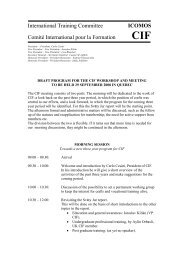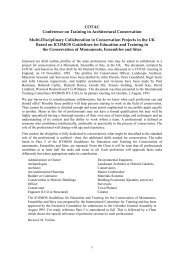Definition of Cultural Heritage -- References to ... - CIF - Icomos
Definition of Cultural Heritage -- References to ... - CIF - Icomos
Definition of Cultural Heritage -- References to ... - CIF - Icomos
Create successful ePaper yourself
Turn your PDF publications into a flip-book with our unique Google optimized e-Paper software.
ICCROM Working Group '<strong>Heritage</strong> and Society' / / JJ<br />
federal rehabilitation proposals. They have also been adopted by a number <strong>of</strong><br />
his<strong>to</strong>ric district and planning commissions across the country.<br />
1985, Council <strong>of</strong> Europe Convention (Architectural <strong>Heritage</strong>)<br />
Convention for the Protection <strong>of</strong> the Architectural <strong>Heritage</strong> <strong>of</strong> Europe (Granada)<br />
... Recalling the importance <strong>of</strong> handling down <strong>to</strong> future generations a system <strong>of</strong><br />
cultural references, improving the urban and rural environment and thereby<br />
fostering the economic, social and cultural development <strong>of</strong> States and regions; ...<br />
1. For the purposes <strong>of</strong> this Convention, the expression 'architectural heritage' shall<br />
be considered <strong>to</strong> comprise the following properties:<br />
1. Monuments: all buildings and structures <strong>of</strong> conspicuous his<strong>to</strong>rical, archaeological,<br />
artistic, scientific, social or technical interest, including their fixtures and fittings;<br />
2. Groups <strong>of</strong> buildings: homogeneous groups <strong>of</strong> urban or rural buildings conspicuous<br />
for their his<strong>to</strong>rical, archaeological, artistic, scientific, social or technical interest<br />
which are sufficiently coherent <strong>to</strong> form <strong>to</strong>pographically definable units;<br />
3. Sites: the combined works <strong>of</strong> man and nature, being areas which are partially built<br />
upon and sufficiently distinctive and homogeneous <strong>to</strong> be <strong>to</strong>pographically<br />
definable and are <strong>of</strong> conspicuous his<strong>to</strong>rical, archaeological, artistic, scientific,<br />
social or technical interest.<br />
1987, ICOMOS Brazil (His<strong>to</strong>ric Centres)<br />
First Brazilian Seminar about the Preservation and Revitalization <strong>of</strong> His<strong>to</strong>ric Centers<br />
(ICOMOS Brazilian Committee, Itaipava, July 1987)<br />
1. Urban his<strong>to</strong>rical sites may be considered as those spaces where manifold<br />
evidences <strong>of</strong> the city's cultural production concentrate. They are <strong>to</strong> be<br />
circumscribed rather in terms <strong>of</strong> their operational value as 'critical areas' than in<br />
opposition <strong>to</strong> the city's non-his<strong>to</strong>rical places, since the city in its <strong>to</strong>tality is a<br />
his<strong>to</strong>rical entity.<br />
2. Urban his<strong>to</strong>rical sites are part <strong>of</strong> a wider <strong>to</strong>tality, comprising the natural and the<br />
built environment and the everyday living experience <strong>of</strong> their dwellers as well.<br />
Within this wider space, enriched with values <strong>of</strong> remote or recent origin and<br />
permanently undergoing a dynamic process <strong>of</strong> successive transformations, new<br />
urban spaces may be considered as environmental evidences in their formative<br />
stages.<br />
3. As a socially produced cultural expression the city adds rather than subtracts.<br />
Built space, thus, is the physical result <strong>of</strong> a social productive process. Its<br />
replacement is not justified unless its socio-cultural potentialities are proven<br />
exhausted. Evaluation standards for replacement convenience should take in<strong>to</strong><br />
account the socio-cultural costs <strong>of</strong> the new environment.<br />
4. The main purpose <strong>of</strong> preservation is the maintenance and enhancement <strong>of</strong><br />
reference patterns needed for the expression and consolidation <strong>of</strong> citizenship. It is<br />
through the outlook <strong>of</strong> the citizen's political appropriation or urban space that<br />
preservation may contribute <strong>to</strong> improve life quality.<br />
5. Considering that one <strong>of</strong> the characteristics <strong>of</strong> urban his<strong>to</strong>rical sites is their<br />
manifold functions, their preservation should not take place at the expense <strong>of</strong><br />
severe use limitations, even when the allowed uses are <strong>of</strong> the kind referred <strong>to</strong> as<br />
cultural. They should, in fact, necessarily shelter both the universes <strong>of</strong> work and<br />
Page 32














